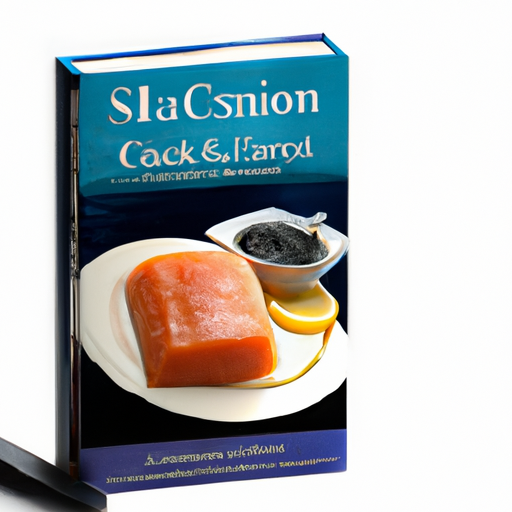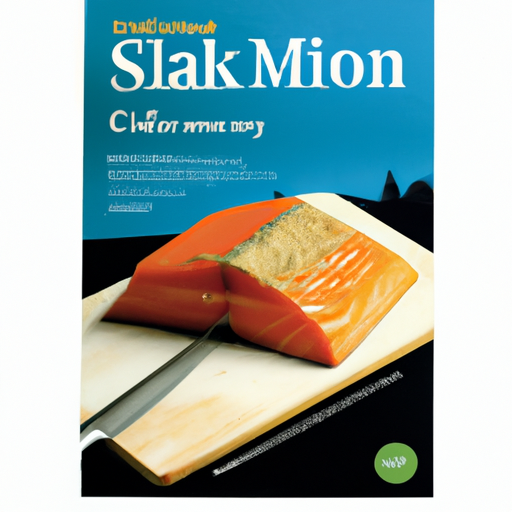Imagine never having to guess if your salmon is perfectly cooked again. With the “Perfectly Cooked Salmon: Omaha Steaks Cooking Guide,” you can achieve restaurant-quality salmon right in the comfort of your own kitchen. This comprehensive cooking chart is your ultimate companion, providing precise cooking times and temperatures for various cuts of salmon. From fillets to whole fish, this guide ensures that your salmon turns out tender, flaky, and full of flavor every time. Say goodbye to overcooked or undercooked salmon and hello to culinary perfection with the “Perfectly Cooked Salmon: Omaha Steaks Cooking Guide.”

Selecting the Right Salmon
When it comes to selecting the right salmon, there are a few factors to consider. One of the first decisions you’ll need to make is whether to choose fresh or frozen salmon. Fresh salmon is typically available at the seafood counter and is ideal if you plan to cook it within a day or two. On the other hand, frozen salmon can be stored for a longer period of time and is a convenient option if you don’t have immediate plans to prepare it.
In addition to the freshness, you’ll also need to consider the type of salmon you want to cook. Some popular types of salmon include Atlantic salmon, sockeye salmon, and chinook salmon. Each type has its own unique flavor profile and characteristics, so it’s worth experimenting with different varieties to find your personal favorite.
Preparing the Salmon
Before you start cooking your salmon, it’s important to properly prepare it. If you’ve opted for frozen salmon, you’ll need to thaw it before cooking. Thawing salmon in the refrigerator is a safe and easy method. Simply transfer the frozen salmon to a plate or a pan and cover it with plastic wrap. Allow it to thaw overnight, or for approximately 8-10 hours. Thawing the salmon slowly in the refrigerator helps to maintain its texture and prevent bacterial growth.
Once your salmon is thawed or if you’re using fresh salmon, it’s time to season it. Seasoning salmon can enhance its natural flavors and add depth to your dish. A simple combination of salt, pepper, and lemon juice or herbs like dill and parsley can work wonders. You can also experiment with marinades or rubs to infuse the salmon with additional flavors. Just be sure to let the salmon sit with the seasonings for at least 30 minutes to allow the flavors to penetrate the fish.
Choosing the Cooking Method
There are various methods you can use to cook salmon, each offering its own unique results. Grilling, baking, and pan-searing are among the most popular cooking methods for salmon. Let’s take a closer look at each technique to help you decide which one suits your preferences.
Grilling is a fantastic way to cook salmon, as it imparts a smoky flavor and creates a delicious charred exterior. To grill salmon, preheat your grill to medium-high heat and oil the grates to prevent sticking. Place the salmon directly on the grill and cook for approximately 4-6 minutes per side, depending on the thickness of the fish.
Baking is another great option for cooking salmon, especially if you prefer a more tender and evenly cooked result. Preheat your oven to 425°F (220°C) and line a baking sheet with parchment paper or aluminum foil. Place the seasoned salmon on the sheet and bake for about 12-15 minutes, or until the salmon flakes easily with a fork.
If you’re looking for a quick and flavorful cooking method, pan-searing is an excellent choice. Start by heating a skillet over medium-high heat and adding a small amount of oil or butter. Once the pan is hot, carefully place the seasoned salmon fillet in the pan, skin side down. Cook for about 4-5 minutes, then flip the salmon and cook for another 2-3 minutes until it’s cooked through.
Determining the Cooking Time
The cooking time for salmon will depend on several factors, including the thickness of the fillets and the cooking method you choose. To ensure that your salmon is cooked to perfection, it’s essential to know the recommended cooking times for each method.
When grilling salmon, a general rule of thumb is to cook it for 4-6 minutes per half-inch of thickness. If you’re using a grill basket or foil pouch, the cooking time may be slightly longer. Keep in mind that the salmon should reach an internal temperature of 145°F (63°C) to be considered safe to eat.
For baking salmon, a good guideline is to cook it for 4-6 minutes per half-inch of thickness at 425°F (220°C). The cooking time may vary slightly depending on the size and thickness of the fillets. To ensure that your salmon is fully cooked but still moist, use a fork to gently test the fish. If it flakes easily and is opaque throughout, it’s ready to be served.
Pan-searing salmon requires a shorter cooking time compared to other methods. On average, you’ll want to cook the salmon for about 4-5 minutes on one side and 2-3 minutes on the other side. The flesh should be slightly pink in the center and opaque around the edges.

Grilling the Salmon
Grilling salmon can be a delightful experience, whether you’re cooking it indoors on a stovetop grill or outside on a charcoal or gas grill. Here are a few tips to help you achieve perfectly grilled salmon.
Before you start grilling, it’s important to properly prepare the grill. If you’re using a charcoal grill, light the charcoal and allow it to burn until it reaches the desired heat level. If you’re using a gas grill, preheat it to medium-high heat. Make sure to clean the grill grates and oil them to prevent the salmon from sticking.
When you’re ready to grill, carefully place the seasoned salmon fillets directly on the preheated grates. Close the grill lid and let the salmon cook for a few minutes. Avoid excessive flipping and poking, as this can cause the fish to break apart. Use a spatula or tongs to gently flip the salmon once the underside is nicely charred.
Continue grilling the salmon for the recommended cooking time, keeping an eye on the fish to prevent overcooking. The salmon should be slightly firm to the touch and opaque in the center. Once it’s done, remove the salmon from the grill and let it rest for a few minutes before serving. This resting period allows the juices to redistribute and ensures a moist and flavorful result.
Baking the Salmon
Baking salmon in the oven is a simple and fuss-free way to achieve tender and flaky fish. Here’s a step-by-step guide to baking salmon to perfection.
Before you start baking, preheat your oven to 425°F (220°C). This ensures that the oven is at the optimal temperature for cooking the salmon evenly. While the oven is heating up, prepare a baking sheet by lining it with parchment paper or aluminum foil. This helps to prevent the salmon from sticking to the pan and makes for easy cleanup.
Once your oven is preheated and the salmon is seasoned, place the fillets on the prepared baking sheet, skin side down. Make sure to leave a little space between each piece to allow for even cooking. Slide the baking sheet into the preheated oven and let the salmon bake for about 12-15 minutes, depending on the thickness of the fish.
While the salmon is baking, avoid opening the oven door unnecessarily. This can cause fluctuations in temperature and extend the cooking time. Instead, use a fork to gently test the fish for doneness. If it flakes easily and is opaque throughout, it’s ready to be enjoyed.
Pan-Searing the Salmon
Pan-searing salmon is a quick and delicious way to enjoy this flavorful fish. Here’s how to pan-sear salmon like a pro.
To start, choose a skillet that is large enough to comfortably hold the salmon fillets without overcrowding. Non-stick pans are ideal for this method, as they prevent the salmon from sticking and ensure easy cleanup. Heat the skillet over medium-high heat and add a small amount of oil or butter. Swirl it around the pan to evenly coat the surface.
Once the pan is hot, carefully place the seasoned salmon fillets in the skillet, skin side down. Allow the salmon to cook undisturbed for about 4-5 minutes. During this time, the skin will crisp up and help hold the fillets together. Use a spatula to gently flip the salmon and cook for another 2-3 minutes, or until the fish is cooked through.
To achieve a beautifully golden crust, resist the urge to constantly move or flip the salmon. Allow the fillets to develop a nice sear on one side before flipping. This will create a delicious caramelized exterior and a tender, moist interior.
Checking for Doneness
It’s crucial to ensure that your salmon is fully cooked before serving to prevent any risk of foodborne illnesses. There are a couple of ways to determine the doneness of your salmon.
Visual cues are one of the easiest ways to check if your salmon is done. The flesh should turn from translucent to opaque as it cooks. Look for the color change to extend from the edges to the center of the salmon. Additionally, the flesh should appear slightly firm to the touch and easily flake when gently prodded with a fork.
For a more accurate measurement, you can also use an instant-read thermometer to check the internal temperature. The USDA recommends cooking salmon to an internal temperature of 145°F (63°C). Insert the thermometer into the thickest part of the fish, avoiding contact with the bone or the pan. Once it reaches the desired temperature, the salmon is ready to be served.
Serving and Enjoying
Now that you’ve cooked the perfect salmon, it’s time to enhance your dining experience by serving and enjoying it. Here are a few suggestions to take your salmon dish to the next level.
Garnishing options can add a burst of flavor and visual appeal to your dish. Consider topping your salmon with a squeeze of lemon juice or a sprinkle of fresh herbs like dill, parsley, or chives. You can also add a dollop of creamy sauce, such as tzatziki or hollandaise, for an extra touch of indulgence. Experiment with different garnishes to find your favorite combination.
When it comes to side dishes, the possibilities are endless. Consider serving your salmon with a refreshing salad, roasted vegetables, or a flavorful grain like quinoa or couscous. The mild, buttery flavor of salmon pairs well with a wide range of ingredients, so feel free to get creative and tailor your sides to your personal taste preferences.
Storing Leftover Salmon
If you have any leftover salmon, it’s important to store it properly to maintain its quality and safety. Here are a couple of options for storing leftover salmon.
Refrigeration is the best option if you plan to consume the leftover salmon within a day or two. Allow the cooked salmon to cool completely before transferring it to an airtight container or wrapping it tightly in plastic wrap. Storing it in the refrigerator at or below 40°F (4°C) helps to slow down bacterial growth and maintain its freshness. Consume the leftover salmon within 2-3 days for the best quality.
Freezing is a great option if you don’t plan to consume the leftover salmon within a few days. Store the cooled salmon in an airtight container or wrap it tightly in plastic wrap. To prevent freezer burn, consider double-wrapping it or using a freezer-safe zip-top bag. Frozen salmon can be stored for up to 2-3 months. When you’re ready to enjoy it, thaw the salmon in the refrigerator overnight before reheating or consuming.
By following these guidelines, you’ll be able to select, prepare, and cook salmon like a pro. Remember to experiment with different flavors and cooking techniques to find your perfect salmon dish. Whether you’re grilling, baking, or pan-searing, a perfectly cooked salmon is sure to impress your family and friends. Enjoy!
